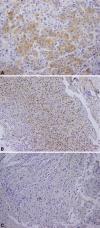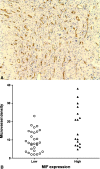Expression of macrophage migration inhibitory factor relates to survival in high-grade osteosarcoma
- PMID: 18563508
- PMCID: PMC2492999
- DOI: 10.1007/s11999-008-0333-1
Expression of macrophage migration inhibitory factor relates to survival in high-grade osteosarcoma
Abstract
Macrophage migration inhibitory factor (MIF), a proinflammatory cytokine, is implicated in many aspects of tumor progression, including cell proliferation, invasion, and angiogenesis. We asked if MIF expression predicts survival and if it is associated with angiogenesis and cell invasion in osteosarcoma. We performed immunohistochemistry for MIF expression in prechemotherapy biopsy specimens of 58 patients with osteosarcoma. To investigate the role of MIF in angiogenesis, microvessel density was measured and compared with MIF expression. We also treated osteosarcoma cell lines (U2-OS and MG63) with MIF and measured vascular endothelial growth factor, a potent proangiogenic factor, by enzyme-linked immunosorbent assay. To study the role of MIF in cell invasion, Boyden chamber assay was performed after knockdown of MIF by short interfering RNA. MIF independently predicted overall survival and metastasis-free survival. MIF expression correlated with microvessel density and induced a dose-dependent increase in vascular endothelial growth factor. Knockdown of MIF by short interfering RNA resulted in decreased cell invasion. These results suggest MIF could serve as a prognostic marker and a potential therapeutic target for osteosarcoma.
Level of evidence: Level II, prognostic study. See the Guidelines for Authors for a complete description of levels of evidence.
Figures





Similar articles
-
Macrophage migration inhibitory factor promotes osteosarcoma growth and lung metastasis through activating the RAS/MAPK pathway.Cancer Lett. 2017 Sep 10;403:271-279. doi: 10.1016/j.canlet.2017.06.011. Epub 2017 Jun 19. Cancer Lett. 2017. PMID: 28642171
-
Overexpression of macrophage migration inhibitory factor induces angiogenesis in human breast cancer.Cancer Lett. 2008 Mar 18;261(2):147-57. doi: 10.1016/j.canlet.2007.11.028. Epub 2008 Jan 2. Cancer Lett. 2008. PMID: 18171602
-
Role of integrin-linked kinase in osteosarcoma progression.J Orthop Res. 2013 Oct;31(10):1668-75. doi: 10.1002/jor.22409. Epub 2013 Jun 19. J Orthop Res. 2013. PMID: 23784942
-
Mechanisms of macrophage migration inhibitory factor (MIF)-dependent tumor microenvironmental adaptation.Exp Mol Pathol. 2009 Jun;86(3):180-5. doi: 10.1016/j.yexmp.2009.01.001. Epub 2009 Jan 7. Exp Mol Pathol. 2009. PMID: 19186177 Free PMC article. Review.
-
Stromal-dependent tumor promotion by MIF family members.Cell Signal. 2014 Dec;26(12):2969-78. doi: 10.1016/j.cellsig.2014.09.012. Epub 2014 Sep 30. Cell Signal. 2014. PMID: 25277536 Free PMC article. Review.
Cited by
-
A novel androstenedione derivative induces ROS-mediated autophagy and attenuates drug resistance in osteosarcoma by inhibiting macrophage migration inhibitory factor (MIF).Cell Death Dis. 2014 Aug 7;5(8):e1361. doi: 10.1038/cddis.2014.300. Cell Death Dis. 2014. PMID: 25101674 Free PMC article.
-
Prognostic significance of macrophage migration inhibitory factor expression in cancer patients: A systematic review and meta-analysis.Medicine (Baltimore). 2020 Aug 7;99(32):e21575. doi: 10.1097/MD.0000000000021575. Medicine (Baltimore). 2020. PMID: 32769903 Free PMC article.
-
Serum and salivary macrophage migration inhibitory factor in patients with oral squamous cell carcinoma.Oncol Lett. 2014 Nov;8(5):2267-2275. doi: 10.3892/ol.2014.2513. Epub 2014 Sep 9. Oncol Lett. 2014. PMID: 25289107 Free PMC article.
-
Prediction of optimal gene functions for osteosarcoma using network-based- guilt by association method based on gene oncology and microarray profile.J Bone Oncol. 2017 Apr 8;7:18-22. doi: 10.1016/j.jbo.2017.04.003. eCollection 2017 Jun. J Bone Oncol. 2017. PMID: 28443230 Free PMC article.
-
OxMIF: a druggable isoform of macrophage migration inhibitory factor in cancer and inflammatory diseases.J Immunother Cancer. 2022 Sep;10(9):e005475. doi: 10.1136/jitc-2022-005475. J Immunother Cancer. 2022. PMID: 36180072 Free PMC article. Review.
References
-
- {'text': '', 'ref_index': 1, 'ids': [{'type': 'PMC', 'value': 'PMC1851138', 'is_inner': False, 'url': 'https://pmc.ncbi.nlm.nih.gov/articles/PMC1851138/'}, {'type': 'PubMed', 'value': '12507885', 'is_inner': True, 'url': 'https://pubmed.ncbi.nlm.nih.gov/12507885/'}]}
- Bacher M, Schrader J, Thompson N, Kuschela K, Gemsa D, Waeber G, Schlegel J. Up-regulation of macrophage migration inhibitory factor gene and protein expression in glial tumor cells during hypoxic and hypoglycemic stress indicates a critical role for angiogenesis in glioblastoma multiforme. Am J Pathol. 2003;162:11–17. - PMC - PubMed
-
- {'text': '', 'ref_index': 1, 'ids': [{'type': 'PubMed', 'value': '8113851', 'is_inner': True, 'url': 'https://pubmed.ncbi.nlm.nih.gov/8113851/'}]}
- Davis AM, Bell RS, Goodwin PJ. Prognostic factors in osteosarcoma: a critical review. J Clin Oncol. 1994;12:423–431. - PubMed
-
- {'text': '', 'ref_index': 1, 'ids': [{'type': 'DOI', 'value': '10.1038/sj.cgt.7701044', 'is_inner': False, 'url': 'https://doi.org/10.1038/sj.cgt.7701044'}, {'type': 'PubMed', 'value': '17479108', 'is_inner': True, 'url': 'https://pubmed.ncbi.nlm.nih.gov/17479108/'}]}
- Ek ET, Dass CR, Contreras KG, Choong PF. Pigment epithelium-derived factor overexpression inhibits orthotopic osteosarcoma growth, angiogenesis and metastasis. Cancer Gene Ther. 2007;14:616–626. - PubMed
-
- None
- Enneking W. Staging musculoskeletal tumors. In: Enneking W, ed. Musculoskeletal Tumor Surgery. New York: Churchill Livingstone; 1983:69–88.
-
- {'text': '', 'ref_index': 1, 'ids': [{'type': 'PubMed', 'value': '14654523', 'is_inner': True, 'url': 'https://pubmed.ncbi.nlm.nih.gov/14654523/'}]}
- Gorlick R, Anderson P, Andrulis I, Arndt C, Beardsley GP, Bernstein M, Bridge J, Cheung NK, Dome JS, Ebb D, Gardner T, Gebhardt M, Grier H, Hansen M, Healey J, Helman L, Hock J, Houghton J, Houghton P, Huvos A, Khanna C, Kieran M, Kleinerman E, Ladanyi M, Lau C, Malkin D, Marina N, Meltzer P, Meyers P, Schofield D, Schwartz C, Smith MA, Toretsky J, Tsokos M, Wexler L, Wigginton J, Withrow S, Schoenfeldt M, Anderson B. Biology of childhood osteogenic sarcoma and potential targets for therapeutic development: meeting summary. Clin Cancer Res. 2003;9:5442–5453. - PubMed
Publication types
MeSH terms
Substances
LinkOut - more resources
Full Text Sources
Medical
Research Materials
Miscellaneous

